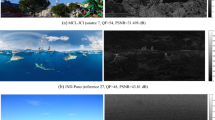Abstract
This paper compares the efficiency of uniform quantization in the spatial domain with frequency dependent quantization in the spatial frequency domain, in the context of the end-to-end performance of visual-communication channels. Results show that the minimum data density required for informationally lossless transmission depends on the design of the image-gathering device. The information in the acquired signal, not the energy, dictates the trade-off between data transmission and visual quality. Frequency dependent quantization that maintains the information capacity of the channel while reducing the entropy of the encoded signal, improves its information efficiency. Information bit-allocation is preferable for optimized visual communication for restoration, whereas energy bit-allocation can be used only for image reconstruction.
Similar content being viewed by others
References
W.F. Schreiber,Fundamentals of Electronic Imaging Systems: Some Aspects of Image Processing. Springer-Verlag, 1986.
C.L. Fales and F.O. Huck, “An information theory of image gathering,”Information Sciences, vol. 57–58, pp. 245–285, 1991.
F.O. Huck, C.L. Fales, R. Alter-Gartenberg, Z. Rahman, and S.E. Reichenbach, “Visual communication: Information and fidelity,”Journal of Visual Communication and Image Representation, vol. 4, no. 2, pp. 62–78, 1993.
F.O. Huck, C.L. Fales, R. Alter-Gartenberg, and Z. Rahman, “On the assessment of visual communication,” inHandbook of Statistics (N. Rose and C.R. Rao, eds.), vol. 10, pp. 479–533, Elsevier Science Publishers, 1993.
R. Alter-Gartenberg, “Optimal visual communication channels,”IEEE Transactions on Communications, March, 1995.
R.J. Clarke,Transform Coding of Images. Academic Press, 1985.
A.N. Akansu and R.A. Haddad,Multiresolution Signal Decomposition. Academic Press, 1992.
Z. Rahman, R. Alter-Gartenberg, and S. Reichenbach, “Discrete cosine transform coding: Information efficiency and fidelity,” inProc. SPIE 1705, Visual Information Processing, pp. 226–237, 1992.
R. Alter-Gartenberg and Z. Rahman, “Multiresolution coding: Information efficiency and fidelity,” inProc. SPIE 1705, Visual Information Processing'92, pp. 214–225, 1992.
R. Alter-Gartenberg, “Irrelevancy reduction in multiresolution imaging,”IEEE Transactions on Communications, 1993. Submitted.
J.W. Modestino and R.W. Fries, “Edge detection in noisy images using recursive digital filtering,”Computer Graphics and Image Processing, vol. 6, pp. 409–433, 1977.
S.K. Park, “Image gathering, interpolation and restoration: A fidelity assessment,” inProc. SPIE 1705, Visual Information Processing'92, pp. 134–144, 1992.
S.E. Reichenbach, S.K. Park, R. Alter-Gartenberg, and Z. Rahman, “Artificial scenes and simulated images,” inProc. SPIE 1569, Image Processing and Computer Vision, pp. 422–433, 1991.
S.K. Park and R. Hazra, “Aliasing as noise: A quantitative and qualitative assessment,” inProc. SPIE 1961, Visual Information Processing'93, pp. 2–13, 1993.
F.O. Huck, C.L. Fales, R. Alter-Gartenberg, and Z. Rahman, “Visual communication: Information and data transmission,”Journal of Visual Communication and Image Representation, vol. 5, no. 3, pp. 282–300, 1994.
C. Shannon and W. Weaver,The Mathematical Theory of Communication. University of Illinois Press, 1964.
S.K. Park and R.A. Schowengerdt, “Image reconstruction by parametric cubic convolution,”Computer Vision, Graphics, and Image Processing, vol. 23, pp. 258–272, 1983.
F.O. Huck, C.L. Fales, N. Halyo, R.W. Samms, and K. Stacy, “Image gathering and processing: Information and fidelity,”Journal of the Optical Society of America A, vol. 2, pp. 1644–1666, 1985.
R. Alter-Gartenberg, “Nonlinear dynamic range transformation in visual communication channels,”IEEE Transactions on Image Processing, 1993. Submitted.
D. Marr, T. Poggio, and E. Hildreth, “Smallest channel in early human vision,”Journal of the Optical Society of America, vol. 70, no. 7, pp. 868–870, 1980.
R. Alter-Gartenberg, C.L. Fales, F.O. Huck, and J.A. McCormick, “Image gathering and processing for high resolution edge detection,” inComputer Vision and Image Processing (L. Shapiro and A. Rosenfeld, eds.), pp. 1–32, AP, 1992.
R. Alter-Gartenberg, F.O. Huck, and R. Narayanswamy, “Image recovery from edge primitives,”Journal of the Optical Society of America A, vol. 7, pp. 898–911, 1990.
Author information
Authors and Affiliations
Additional information
This research was supported by NASA Task Assignment NAS1-18584-90 with the Department of Mathematics, Old Dominion University, Norfolk, Virginia 23529.
Rights and permissions
About this article
Cite this article
Alter-Gartenberg, R. Efficient visual communication channels. J Math Imaging Vis 5, 59–76 (1995). https://doi.org/10.1007/BF01250253
Issue Date:
DOI: https://doi.org/10.1007/BF01250253




